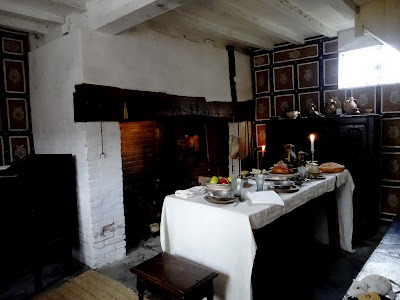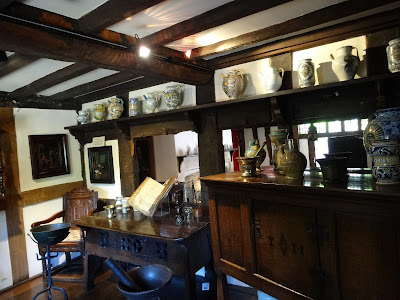Our main objective on the third day of our trip was to visit the neolithic longbarrow of Belas Knapp but on the way we passed through Winchcombe where we stopped for a quick look round. The photo above shows a 15th century merchant's house which is now a restaurant, the whole town is full of historic buildings. It is Anglo Saxon in origin and the layout in the centre of the town has remained virtually unchanged since medieval times. If I'd known how interesting it was going to be I'd have allowed more time to look around but we'd only taken an hour in the car park so only had time for a quick sprint round.
We decided that the church sounded interesting and that we would spend what time we had in there. St Peter's dates back to 1470 but stands on the site of an earlier church. The Benedictine Winchcombe Abbey once stood close to the east end. The Abbey was founded in 798AD and was demolished in 1539 - Henry VIII at work again with his Dissolution of the Monasteries!
St Peter's has forty wonderful grotesques- I loved this one:) Grotesques are just carved figures, it's the gargoyles that were originally water spouts. Apparently this one was the inspiration for the Mad Hatter in Lewis Carroll's Alice in Wonderland. I wish we'd had time to look for all of them.
The base and shaft of the font date from 1654 and the lovely painted font cover is mid 18th century. The bowl is a replacement for the one that was destroyed during the Civil War but there is a discreet silence about whether the Royalists or the Roundheads were responsible - I know which I'd bet on:) Behind the font is one of two Saxon stone coffins, one is thought to be that of King Kenulf and the other of his son St Kenelm both of whom were buried in the nearby Abbey church. Kenulf or Coenwulf was King of Mercia from 796AD until his death in 821AD.
This 14th century altar cloth is made from pieces of vestments and it's thought that it was stitched together and the border embroidered by Catherine of Aragon the first wife of Henry VIII during a stay at nearby Sudeley Castle. Sudeley is another place on my list of places to go on my next visit to the Cotswolds. The curtains are kept closed to protect the fragile fabrics from the light, a guardian opens them when someone wants to look at the altar cloth.
Here we have a statue which represents King Kenulf who founded the Benedictine Abbey that once stood nearby. The statue isn't very old - 1872 to be exact. It was given to St Peter's by Mrs Emily Dent who paid for the restoration of the church in the 1870s.
A beautiful medieval carved oak screen which once separated the nave and the chancel but has now been moved to the west end of the church. Can you see the imp?
Here he is:) Look at the third panel from the left in the previous photo.
The church is full of wonderful old things - this is the medieval Alms Box. It had three locks and one key was kept by the vicar and the other two by the churchwardens. The box could only be opened when all three were present. The church and the town both deserved more time than we were able to give them and I would definitely like to go back - maybe next year.
Belas Knapp is quite close to Winchcombe but spotting the narrow lane where the path up Cleve Hill begins is not easy if you don't know what you're looking for. Fortunately a local lady gave us precise instructions before we left Winchcombe. It's quite a long steep climb up to Belas Knapp but there are some wonderful views on the way up.
Belas Knapp is an early neolithic long barrow and was constructed about 3600/3700BC . It's about 50 metres ( 164 feet) long and 4 metres (13 feet) high. I've borrowed an aerial photograph from English Heritage to give you a proper idea of what it looks like.
The skeletons of five children and a young man were found behind the stones of this portal setting with its projecting horns which formed a forecourt for ceremonial use presumably when burials were taking place. It was also possibly used at certain times of the year for ceremonies connected with the ancestors who were very important to neolithic people. My theory not an official one!
The barrow has four burial chambers and the remains of at least 38 people were found during various excavations. Fourteen skeletons were in this chamber which is on the north eastern side of the mound.
One of the two chambers set into the north western side, the fourth is on the narrow south east side but there is very little to see of that one.
Belas Knapp is in a wonderful position with lovely views in every direction. The barrow itself is covered in wildflowers including lots of wild thyme, yarrow and scabious. This lovely butterfly is, I think, a Marbled White. We were lucky to have Belas Knapp entirely to ourselves so we were able to absorb the tranquil atmosphere undisturbed. We met one couple coming down as we climbed up to it and as we were going down two more people were on their way up but that was it.
Eventually we made our way slowly back down Cleve Hill and set off towards Painswick. But that is for next time.





























































